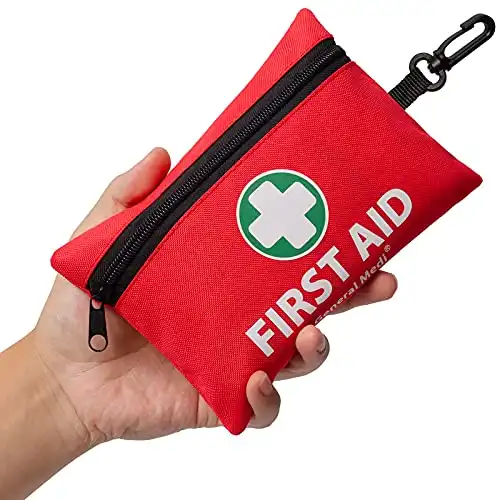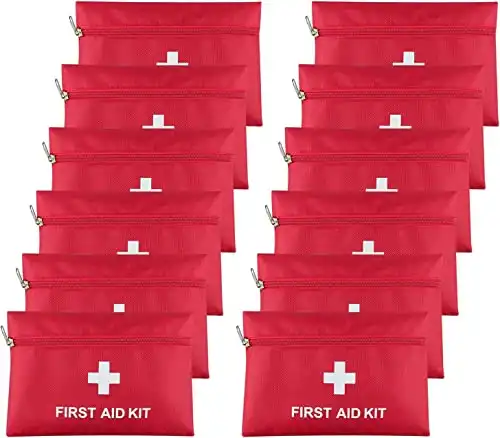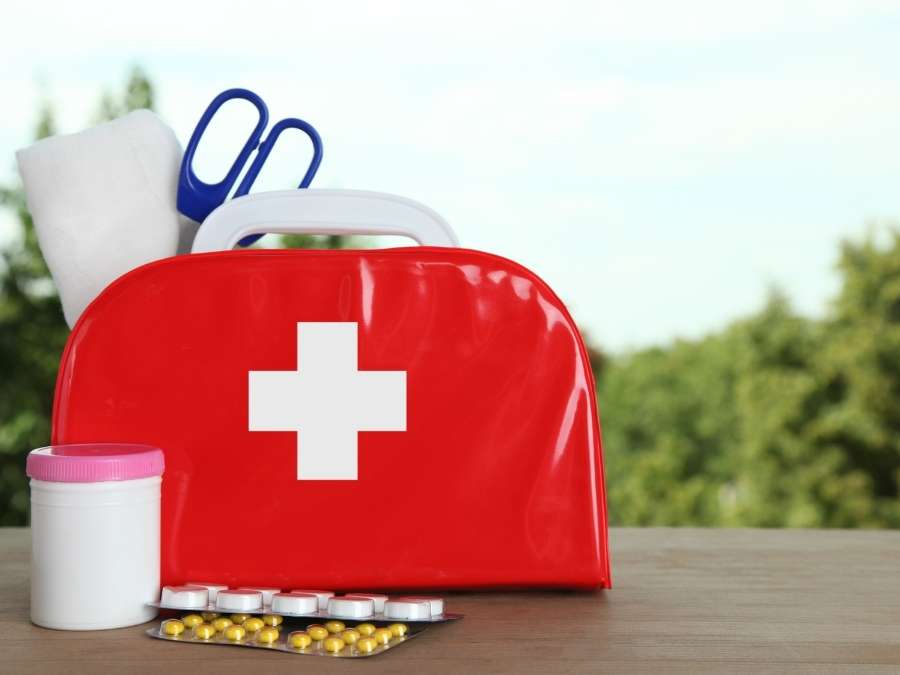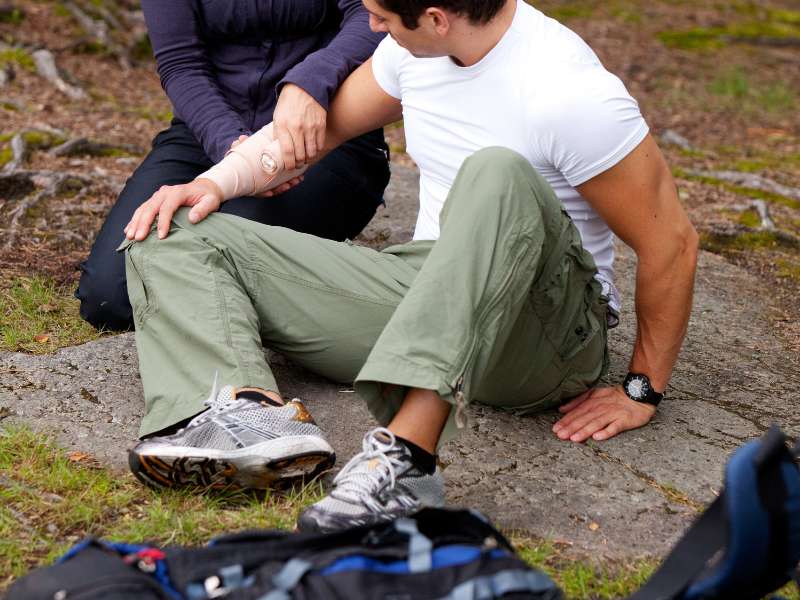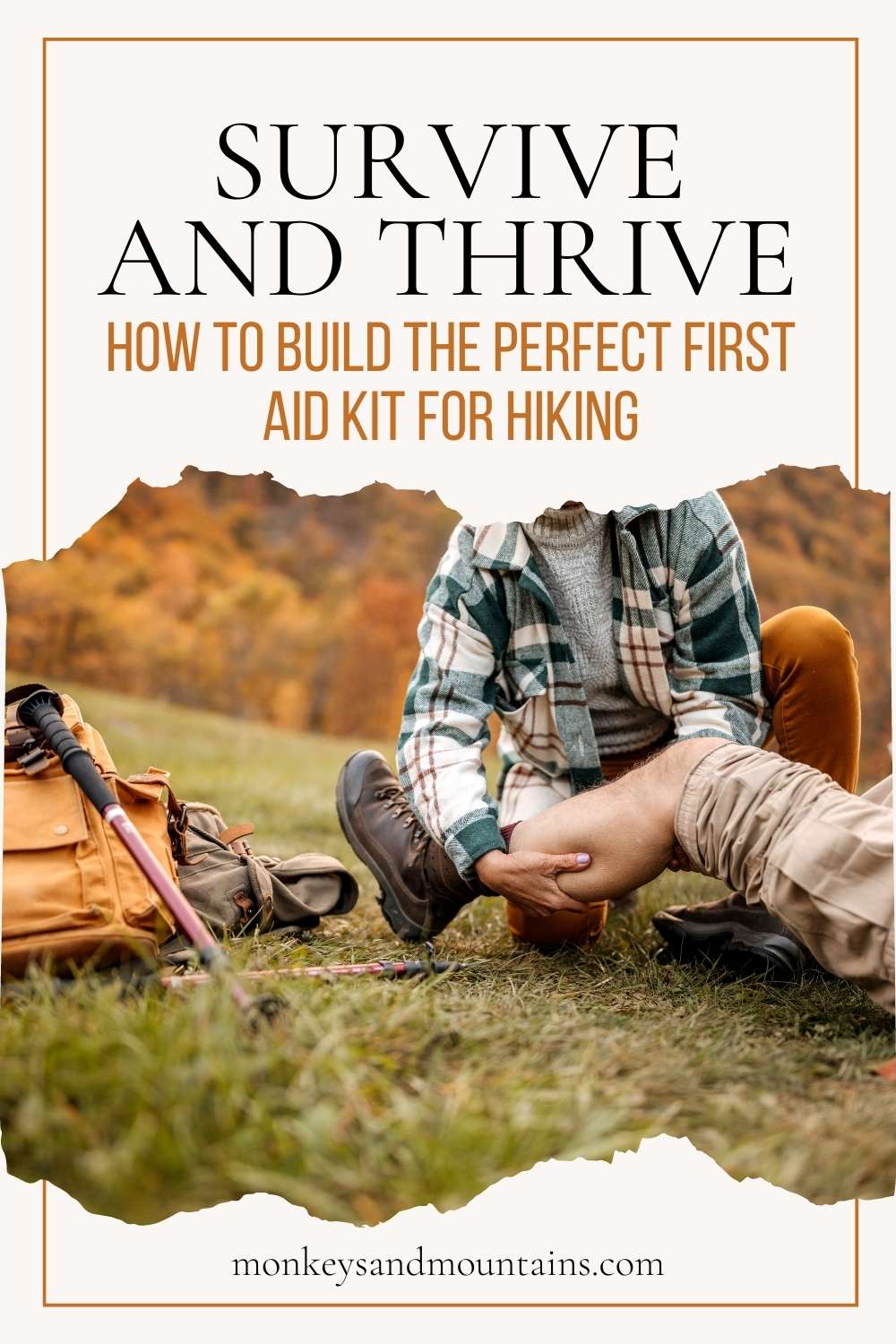Rolled ankles or minor cuts from bushes are fairly common occurrences when hiking. That’s why you need a first aid kit for hiking as part of your outdoor gear so that you’re prepared for the most common minor injuries and can address them before they turn into a medical emergency.
In this guide, I’ll walk you through the essential items you need in a hiking first aid kit, along with some extra items that you can consider adding to personalize it for your outdoor adventure or medical needs.
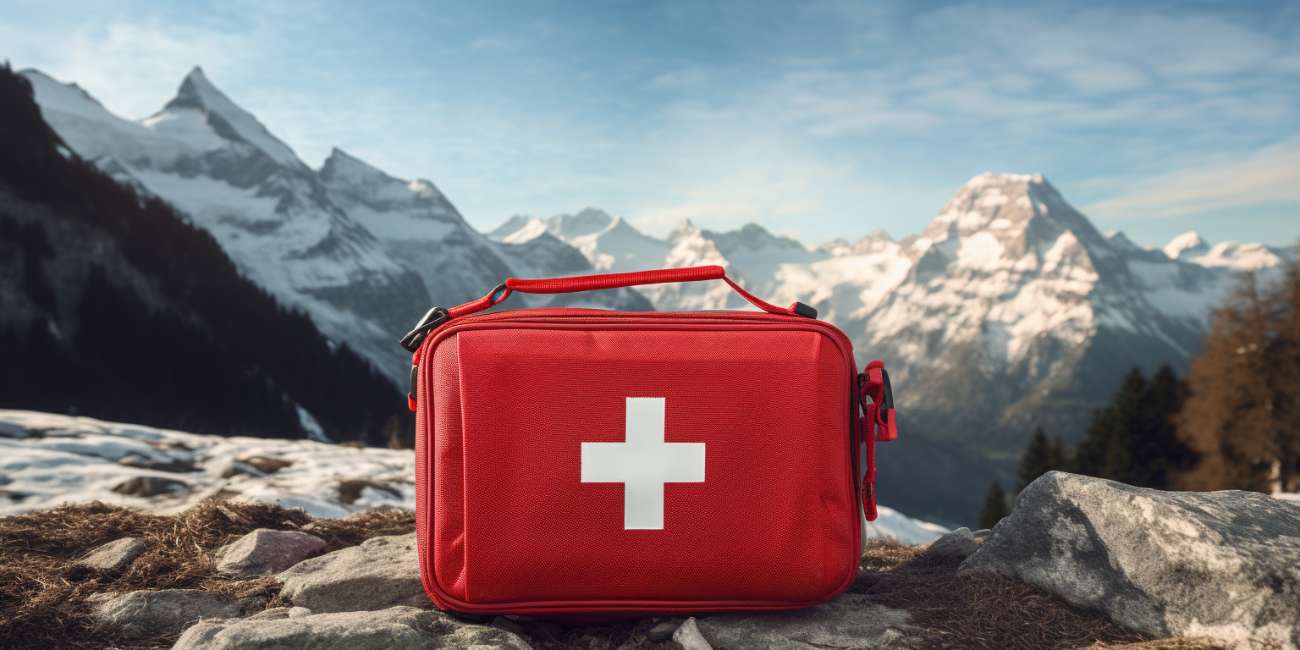
Most Common Minor Injuries That Occur While Hiking
Table of Contents
To assess what medical supplies you need in your hiking first aid kit, we first need to look at the most common type of injuries that happen to walkers and hikers.
Chafing
Most commonly occurs on the inner thighs from rubbing when hiking for hours, especially in warm weather, or around the armpits from an ill-fitting backpack. I recommend bringing a blister balm since it can also be used to treat blisters, which is another common injury. If you don’t have blister balm, then Vaseline can help reduce friction and prevent further chafing.
Blisters
Blisters are one of the most common minor injuries that hikers get and are often from poorly fitting hiking boots, or ones not worn in properly, or if your feet have gotten wet. You can use a blister balm at the first indication before a blister forms. Also, be sure to check out our other tips on how to prevent blisters.
Cuts and Scratches
Depending on the terrain, it’s easy to cut or scratch yourself on thorny bushes or cactus spines if you’re hiking somewhere like in Joshua Tree National Park.
Elastoplast tape can be cut to size to cover small to medium cuts and scratches. This means you don’t have to carry lots of different sizes of plasters. You’ll also want to use an antiseptic spray or an antiseptic towelette before putting a bandage over it to prevent infection.
Tweezers are also helpful as a splinter remover or to pull out thorns or stingers from bees or wasps.
Minor Allergic Reactions
If you have a minor allergic reaction to a wasp sting or to vegetation like poison ivy, it’s a good idea to bring a few antihistamine tablets. There’s no need to carry the whole pack unless you’re doing a multi-day hike. Just cut the plastic for 1-2 doses to keep the weight and bulk down.
Rolled or Sprained Ankle or Knee
If you sprain your ankle, as I have on several hikes, and still have to finish your hike, you’ll definitely want to ensure you have several pain relief tablets. I recommend ibuprofen since it’s anti-inflammatory and will help reduce the swelling and the pain.
In addition, you’ll want to wrap it in a tensor bandage to help reduce the swelling and provide additional support.
Dehydration
Most people hike when it’s warm, and if you’re hiking in an area without shade, like scrambling up a mountain, it’s easy to get dehydrated. While it’s important to drink enough water, I also recommend bringing electrolyte tablets.
These help replenish nutrients that you sweat out and will help keep you hydrated better than water alone.
Hypothermia/Weather Protection
In case you do get stuck on the mountain and can’t get down due to a torn ligament in your knee or sprained ankle and you have to spend the night outdoors until emergency rescue can come, I recommend an emergency blanket.
While you may never have to use it, it’s essential for every hiker. I ALWAYS have one in my backpack, even when hiking in summer, since temperatures can drop dramatically when the sun goes down.
List of Essential First Aid Supplies for Hikers
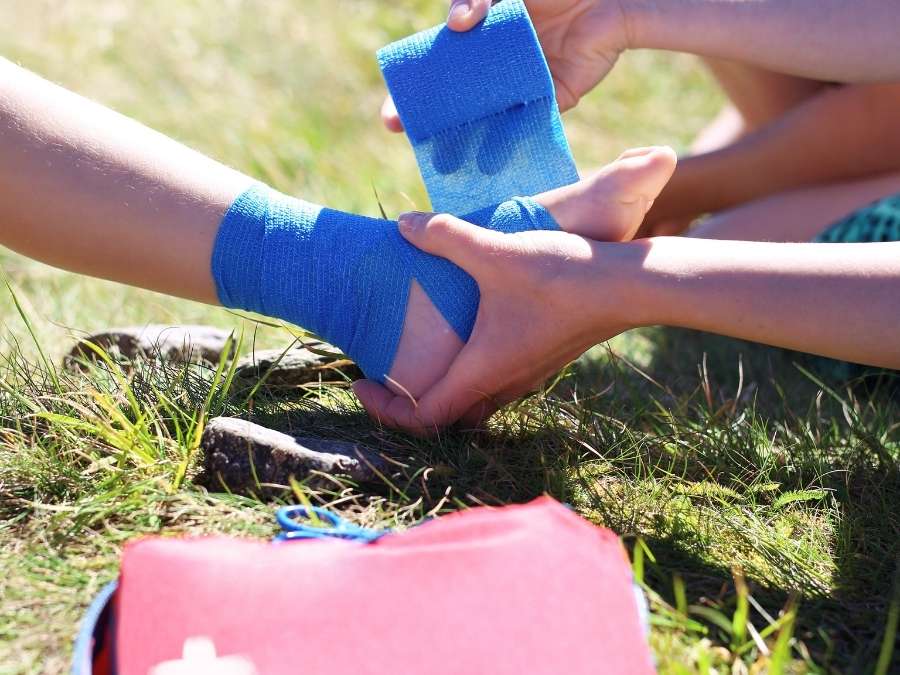
- Blister balm
- Compeed or other bandages designed to cover blisters
- Adhesive bandages like Elastoplast tape that you can cut to size (and knife or scissors to cut it)
- Tweezers
- Antiseptic spray or antiseptic wipes
- Antihistamine tablets
- Ibuprofen
- Tensor or elastic bandage
- Emergency thermal blanket
- Electrolyte tablets
My #1 Recommended First Aid Kit for Hikers
A good first aid kit for hiking should contain all the essentials you need to treat minor injuries. While you could easily bring a ton of medical supplies, in reality, most of them you’ll never use.
So unless you’re doing a really remote hike where it will take days for the emergency response team to reach you, I recommend keeping your aid kit supplies to a minimum.
That way, you’re more likely actually to bring them on every hike. I keep mine in my backpack at all times so that I don’t forget them.
The #1 First Aid kit for hiking that I’d recommend is the
This mini first aid kit is an excellent choice for hikers because it contains all of the above-mentioned items and more with 110 items, even an emergency blanket, which, as you know, I think is an essential piece of outdoor gear. The only thing it's missing is the blister balm, but it does have bandages.
The other feature that i like the best is that it's compact and only weighs 0.35 pounds. In my experience, if your hiking first aid kit is light and doesn't take up much space, you're more likely to bring it on your next hike.
I also like that it's waterproof and has a carabiner so you could attach it to the outside of your backpack if you didn't have room inside.
Alternatively, you can also customize and build your own hiking first aid kit based on my recommendations above and the terrain where you’ll be hiking. If you do that, then I recommend this:
It's super compact, weighing just 12 oz and comes in a pack of 12, so you can store one in your car and give the others to family or friends you hike with. If you're on medication, you could also use one bag to store that while hiking.
Very importantly, it's waterproof, which is essential for a first aid kit bag since you don't want your bandages to get wet.
I personally like customizing my hiking first aid kit since I find there are certain items I use fairly frequently, like Moleskin for blisters and others that I never use, like pre-cut bandages of certain shapes.
While you can find a wide range of adventure medical kits, many of them contain a LOT of extra supplies, like disposable syringes or thermometers, that most hikers will never need.
However, if you’re curious as to what should be in a more comprehensive first aid kit for hiking, or will be hiking in a remote area, then see the Washington Trails Association recommendations.
If you’re going for day hikes, then a minimal first aid kit just for hiking with the essentials is all you need. A more comprehensive one just adds bulk and weight, making you less likely to carry a first aid kit.
That’s why I’ve only recommended a compact-size kit that will treat the most common range of injuries that hikers experience.
Customizing Your First Aid Kit
Tailor your first aid kit to your specific hike or outdoor activities and personal medical needs.
Consider factors such as the duration of your hiking trip, the remoteness of your hike, and any pre-existing medical conditions and terrain.
For example, if poisonous snakes are common where you’re hiking, I would consider bringing a snake bite kit.
Or, if you’re doing a multi-day backpacking trip in remote mountains, I always bring a roll of duct tape since it can be used for medical and a variety of other purposes, like covering a hole in your tent, as I learned from personal experience.
If you frequently experience dry eyes as I do, then I’d bring a saline solution or other drops to relieve dry eyes.
Or in my experience, when was recovering from knee surgery, I would wrap my knee in athletic tape before I started hiking and would bring it if I was doing a multi-day hike. If you suffer from a common overuse injury like knee pain or shoulder pain you may want to do the same.
But one thing that applies to every first aid kit is to ensure that it’s, at a minimum, water resistant but even better waterproof. That way, it will last for years, and your medical supplies will stay intact.
The other important item to remember is to refill supplies after you’ve used aid items. You want to ensure that it’s always well stocked.
First Aid Training
A well-stocked first aid kit is only as useful as your ability to use it. Familiarize yourself with basic medical training, and consider enrolling in a wilderness first aid course or Wilderness First Responder course to further enhance your skills.
You can find them at the Red Cross and the National Outdoor Leadership School, but other organizations also offer similar types of training.
Conclusion
In conclusion, a good first aid kit is an essential item for any hiker. Choose a kit that’s compact, waterproof, and contains all the necessary items to treat minor injuries and illnesses.
